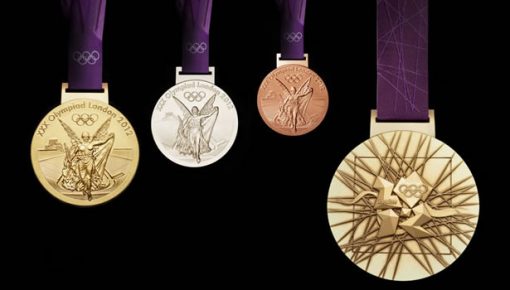Countless fans have taken the opportunity to admire the gold, silver and bronze victory medals awarded to winners at the 2012 London Olympic Games. While the medals serve as a symbol of the achievement, many view them as works of art.

That additional level of admiration is not without merit, thanks to the UK Royal Mint. The facility was responsible for striking the London 2012 Olympic medals as well as the medals for the upcoming London 2012 Paralympics. In total, an estimated 4,700 victory medals were produced by the Royal Mint for the two sporting events.
The process of creating them started long ago. The Olympic version was designed by David Watkins with credit for the Paralympic design given to Lin Cheung.
Victory Medal Designs
As is traditional, the obverse of the Olympic piece depicts Nike, the Greek Goddess of Victory, stepping from the Panathinaiko Stadium. The stadium hosted the first modern Olympic Games in 1896. The reverse shows the Olympic Games logo along with the River Thames and a series of lines representing "the energy of athletes and a sense of pulling together."
The obverse for the Paralympic medal depicts ‘Spirit in motion’, the Paralympic motto. It also features a close-up section of an outstretched wing of the Greek Goddess of Victory. Shown on the reverse is a representation of ‘the heart of victory’ with a design incorporated from a direct mold of the heart area of the plaster cast of ‘The Nike of Paionios’ which resides in the British Museum Cast Collection.
With medal design work completed, Royal Mint Chief Engraver Gordon Summers set about the task of overseeing the creation of the dies used to strike them, the Mint relates. It explains how new procedures were developed to create the dies because the medals are the biggest and heaviest ever created for the Olympic and Paralympic games.
In summary, using a hydraulic press with a pressure of 900 tonnes, the dies were struck against the blanks five times. Before the process was completed, each medal was struck another ten times to completely impart the intricate details. Following that step, each medal was edged, weighed, mounted and hand finished.
Specifications for the Olympic and Paralympic Medals are offered below:
2012 Olympic and Paralympic Medal Specifications
| Gold Medal | Silver Medal | Bronze Medal | |
| Composition | 1.34% gold (6g min.) 92.5% silver; remainder copper |
92.5% silver 7.5% copper |
97.0% copper 2.5% zinc 0.5% tin |
| Diameter | 85mm | 85mm | 85mm |
| Thickness | 8-10mm | 8-10mm | 8-10mm |
| Weight | 412g | 412g | 357g |
Despite the gold and silver medals having intrinsic value, the true worth of each is as they are. They are prized by many around the world with the Royal Mint offering this recent example:
"On March 29th 2012 Wladimir Klitschko, a Ukrainian world heavyweight-boxing champion, raised $1m for charity by auctioning his gold medal from 1996. The medal was immediately returned by the buyer out of respect for the achievement it represented."
The Royal Mint states that 22 stages were involved in the making of each London 2012 Olympic medal, and that does not include 21 separate inspections.





